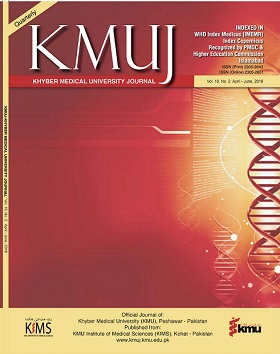EFFECTIVENESS OF VARIOUS TEACHING METHODOLOGIES IN DEVELOPING CLINICAL REASONING SKILLS IN UNDERGRADUATE FEMALE MEDICAL STUDENTS
Main Article Content
Abstract
ABSTRACT
OBJECTIVE: To compare the effectiveness of “summarize, narrow, analyze, probing, management plan, select a topic” (SNAPPS) model, one-minute preceptor (OMP) and traditional clinical teaching in developing clinical reasoning skills of final year undergraduate female medical students in pediatrics clinical setting.
METHODS: This randomized control trial was conducted at Department of Pediatrics, Peshawar Medical College from February to July 2016. Students were randomly distributed in three groups i.e. SNAPPS, OMP and traditional teaching with 20 students in each group. All 60 students were exposed to pre-test including 4 Key Feature Problems (KFPs). Students were then taught on pre-identified 4 topics with one topic /week by respective teaching methodology. Each topic was followed by post-test using 4 KFPs. The pre-test and post-test results were recorded and analyzed on SPSS-20. ANOVA was used as test for finding significance.
RESULTS: All 60 female students of final year completed the study and none dropped out. The mean marks of pretest of three groups were 12.50±0.15 with minimum number of 4±1 marks and maximum of 23±1. There was no significant difference in pre-test among the groups using ANOVA (p = .984). However, significant difference (p< 0.001) was observed in post-test among groups after intervention. There was statistically significant difference (p<0.001) in favor of SNAPPS as compared to traditional teaching methodology. There was no significant difference between OMP and traditional method.
CONCLUSION: SNAPPS is significantly more effective in improving clinical reasoning than OMP and traditional teaching method in female undergraduate medical students in pediatrics clinical setting.
KEY WORDS: Clinical reasoning (Non-MeSH); SNAPPS (Non-MeSH); One-minute preceptor (Non-MeSH); Key feature problems (Non-MeSH); Education, Medical, Undergraduate (MeSH)
Article Details
Work published in KMUJ is licensed under a
Creative Commons Attribution 4.0 License
Authors are permitted and encouraged to post their work online (e.g., in institutional repositories or on their website) prior to and during the submission process, as it can lead to productive exchanges, as well as earlier and greater citation of published work.
(e.g., in institutional repositories or on their website) prior to and during the submission process, as it can lead to productive exchanges, as well as earlier and greater citation of published work.
References
REFERENCES
Elstein AS. Thinking about diagnostic thinking: A 30-year perspective. Adv Health Sci Educ Theory Pract 2009 Sep;14 Suppl 1:7-18. DOI: 10.1007/s10459-009-9184-0.
Ramani S, Leinster S. AMEE Guide no. 34: Teaching in the clinical environment. Med Teach 2008;30(4):347-64. DOI: 10.1080/01421590802061613.
Spencer J. ABC of learning and teaching in medicine: Learning and teaching in the clinical environment. BMJ 2003;326(7389):591–4.DOI: 10.1136/bmj.326.7389.591
Wolpaw TM, Wolpaw DR, Papp KK. SNAPPS: A learner-centered model for outpatient education. Acad Med 2003;78(9):893–8.
Neher JO, Gordon KC, Meyer B, Stevens N. A Five-Step “ Microskills ” Model Of Clinical Teaching. J Am Board Fam Pract 1992;5(4):419-24.
Bowen JL. Educational Strategies to Promote Clinical Diagnostic Reasoning. N Engl J Med 2006;355:2217–25. DOI: 10.1056/NEJMra054782
Eva KW. What every teacher needs to know about clinical reasoning. Med Educ 2005;39(1):98-106.DOI: 10.1111/j.1365-2929.2004.01972.x
Edwards I, Jones M, Carr J, Braunack-Mayer A, Jensen GM. Clinical reasoning strategies in physical therapy. Phys Ther 2004;84(4):312–30; discussion 331–5.
Paucard-Dupont S, Marchand C. Exploratory study of clinical reasoning in nursing students with concept mapping. Rech Soins Infirm 2014;(117):85–112.
Lockspeiser TM, Kaul P. Applying the One Minute Preceptor Model to Pediatric and Adolescent Gynecology Education. J Pediatr Adolesc Gynecol 2015;28(2):74–7.DOI: 10.1016/j.jpag.2014.07.014
Aagaard E, Teherani A, Irby DM. Effectiveness of the one-minute preceptor model for diagnosing the patient and the learner: proof of concept. Acad Med 2004;79(1):42–9.
Wolpaw T, Papp KK, Bordage G. Using SNAPPS to facilitate the expression of clinical reasoning and uncertainties: a randomized comparison group trial. Acad Med 2009;84(4):517–24. DOI: 10.1097/ACM.0b013e31819a8cbf.
Farrell SE, Hopson LR, Wolff M, Hemphill RR, Santen SA. What’s the Evidence: A Review of the One-minute Preceptor Model of Clinical Teaching and Implications for Teaching in the Emergency Department. J Emerg Med 2016;51(3):278-3. DOI: 10.1016/j.jemermed.2016.05.007.
Schmidt HG, Boshuizen HP. On the origin of intermediate effects in clinical case recall. Mem Cognit 1993;21(3):338–51.
Schmidt HG, Norman GR, Boshuizen HP. A cognitive perspective on medical expertise: theory and implication. Acad Med 1990;65(10):611–21.
Linn A, Khaw C, Kildea H, Tonkin A. Clinical reasoning: A guide to improving teaching and practice. Aust Fam Physician 2012;41(1-2):18–20.
Levett-Jones T, Hoffman K, Dempsey J, Jeong SY, Noble D, Norton CA, et al. The “five rights” of clinical reasoning: An educational model to enhance nursing students’ ability to identify and manage clinically “at risk” patients. Nurse Educ Today 2010;30(6):515–20.DOI: 10.1016/j.nedt.2009.10.020
Artino AR Jr, La Rochelle JS, Dezee KJ, Gehlbach H. Developing questionnaires for educational research: AMEE Guide No. 87. Med Teach 2014;36(6):463–74.DOI: 10.3109/0142159X.2014.889814
Gay S, Bartlett M, McKinley R. Teaching clinical reasoning to medical students. Clin Teach 2013;10(5):308–12.DOI: 10.1111/tct.12043.
Rencic J. Twelve tips for teaching expertise in clinical reasoning. Med Teach 2011;33(11):887–92.DOI: 10.3109/0142159X.2011.558142.
Page G, Bordage G. The Medical Council of Canada’s key features project: a more valid qritten examination of clinical decision-making skills. Acad Med 1995;70(2):104–10.
Hrynchak P, Takahashi SG, Nayer M. Key-feature questions for assessment of clinical reasoning: A literature review. Med Educ 2014;48(9):870–83. DOI: 10.1111/medu.12509.
Farmer EA, Page G. A practical guide to assessing clinical decision-making skills using the key features approach. Med Educ 2005;39(12):1188–94.DOI: 10.1111/j.1365-2929.2005.02339.x
Heinerichs S, Vela LI, Drouin JM. A learner-centered technique and clinical reasoning, reflection, and case presentation attributes in athletic training students. J Athl Train 2013;48(3):362–71DOI: 10.4085/1062-6050-48.2.17..
Sawanyawisuth K, Schwartz A, Wolpaw T, Bordage G. Expressing clinical reasoning and uncertainties during a Thai internal medicine ambulatory care rotation: Does the SNAPPS technique generalize? Med Teach 2015;37(4):379-84. DOI: 10.3109/0142159X.2014.947942.
Seki M, Otaki J, Breugelmans R, Komoda T, Nagata-Kobayashi S, Akaishi Y, et al. How do case presentation teaching methods affect learning outcomes?-SNAPPS and the One-Minute preceptor. BMC Med Educ 2016;16(1):12.DOI: 10.1186/s12909-016-0531-6.
